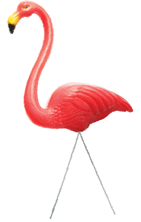 |
||||||||

Do Fertilizer Ordinances Work? TBEP Study Aims to Find Out
The Tampa Bay Estuary Program has launched a 3-year research project to assess whether restrictions on residential fertilizer use result in water quality improvements.
"There have been some pretty dramatic results in other states, but nothing has been done specifically in Florida," notes Nanette O'Hara, public outreach coordinator for the estuary program.
The work will compare nitrogen levels in stormwater ponds in selected communities within Hillsborough, Manatee and Pinellas counties, which have all adopted different lawn and landscape fertilizer ordinances. For example, Pinellas County has a total ban on use and sales of nitrogen fertilizer in the summer; Manatee County has a summer ban on use only; and Hillsborough County does not ban either use or sale of nitrogen products.
The goal of the research is to determine which, if any, of the ordinances is successful at reducing nitrogen pollution in area waterways, and to what extent.
The communities to be studied consist of sections of newer subdivisions with stormwater ponds, where the primary source of the stormwater is the homes within the study area. Water quality sampling for nitrogen will be conducted in these ponds during both wet and dry seasons to detect changes in nitrogen levels.
Sources of nitrogen can be tracked using isotopes that identify whether it came from animal waste, fertilizer or atmospheric deposition, she adds.
Social surveys also will determine whether, and to what extent, homeowners in those neighborhoods have changed their lawn care practices as a result of the ordinances and associated educational programs. "A secondary goal is to determine how well education works," O'Hara said.
The work will be conducted by a team led by Applied Ecology, Inc., in partnership with researchers from the University of Central Florida and the University of Florida.
More than 40 communities in Florida have enacted fertilizer ordinances since 2007, but this study is the first effort to measure how effective they are at reducing nitrogen in waterways. Quantifying the water quality benefits of fertilizer ordinances could help local governments meet new regulatory requirements for reducing nutrient pollution in their streams, lakes and bays.
"If we can prove that fertilizer regulations protect water quality, they could become a significant consideration in the regulatory arena," she said.
TBEP hopes that the local governments participating in the project will continue the water quality sampling after the study ends, to track long-term trends in nitrogen levels resulting from the ordinances.
Funding for the $200,000 project is being provided equally by the Estuary Program and Pinellas County, with in-kind contributions from the City of Tampa, Manatee County, and the Environmental Protection Commission of Hillsborough County.

As the summer ban expires for the year, partners of the Be Floridian fertilizer education campaign urge residents to apply fertilizers judiciously.
Garden centers in Pinellas County offer a variety of fertilizers that comply with the county’s fertilizer ordinance. Products on the store shelves from October through May must contain at least 50% of the nitrogen in a slow-release (or timed release) form.
In other counties, residents can look for fertilizers that release nitrogen gradually, nourishing lawns and plants for a longer period of time. They also help keep our environment healthy, since they are more likely to be absorbed by the plants and less likely to run off into waterways when it rains. Too much nitrogen is the biggest source of pollution in our lakes, ponds, Tampa Bay and the Gulf of Mexico.
If you choose to fertilize, October is a good month to do it. Gardening experts do not recommend use of fertilizers during the coldest winter months because grass and plants are not actively growing and cannot utilize the nutrients.
 Here are a few additional tips to keep both your landscape and our waterways healthy through the fall and winter:
Here are a few additional tips to keep both your landscape and our waterways healthy through the fall and winter:
- Fertilize only when you are looking for a particular plant response such as growth, more blooms or to correct a nutritional deficiency. If your plants and grass look healthy, hold off on the fertilizer.
- Make sure your cold-sensitive plants have been planted in the warmest sites on your property - usually south-facing areas protected by walls, fences or evergreen hedges. Better yet, choose plants that will easily tolerate winter temperatures. We’ve all learned hard lessons in recent years about the expense of constantly replacing plants killed by winter freezes! "Right plant, right place" also means taking into account temperature extremes.
- Reduce irrigation frequency in the fall and winter as plant growth slows. Your lawn only needs watering about once a week in the fall, and once every 10-14 days in the winter. If it rains, don’t water!
- Provide tree shade or cover to guard against "radiation" freezes that occur on cold, clear, windless nights when heat "radiates" into the air from plants. Providing a tree canopy helps plants hold the heat they generate and prevents it from escaping into the night sky.
- Add 2-3 inches of mulch to hold in both heat and moisture during dry winter months, and moderate soil temperatures. Choose eco-friendly mulches like pine straw, pine bark or eucalyptus chips. Don’t bag those leaves that fall in the autumn; use them as mulch instead!
- Avoid pruning in early fall; that extra growth will help protect your plants on chilly nights.
For more tips on how to Be Floridian, visit www.befloridian.org.
For information on the Pinellas County Fertilizer Ordinance visit http://www.pinellascounty.org/environment/watershed/fertilizer.htm.
For general landscape questions, and info about Florida-Friendly Landscaping™ visit http://pinellas.ifas.ufl.edu/FFL/index.shtml.
